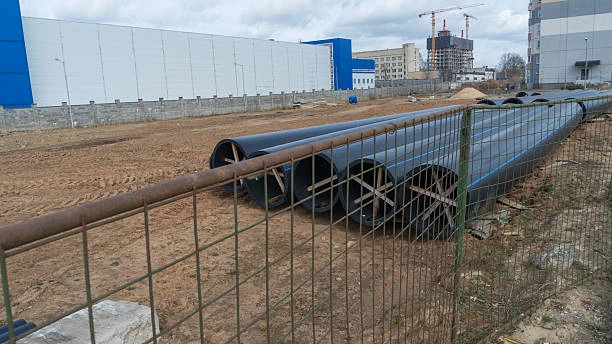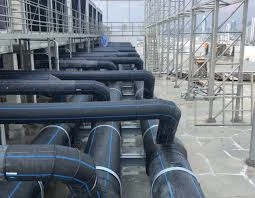Introduction
HDPE (High-Density Polyethylene) fittings are essential components in modern piping systems, offering leak-proof connections, chemical resistance, and long-term durability. Whether for plumbing, irrigation, or industrial applications, choosing the right HDPE fitting ensures a reliable and efficient piping network.
This guide explores the different types of HDPE fittings, their uses, and why they outperform traditional metal or PVC fittings in many applications.
What Are HDPE Fitting?
HDPE fittings connect HDPE pipes to form secure, leak-free systems. Manufacturers design them for:
- High-pressure resistance
- Corrosion and chemical resistance
- Flexibility and impact resistance
- Long lifespan (50+ years)
Unlike glued or threaded fittings, most HDPE fittings use heat fusion (butt welding or electrofusion) for permanent, leak-proof joints.
Types of HDPE Fitting & Their Uses
1. Butt Fusion Fitting
- Design: Connect pipes end-to-end using heat fusion.
- Uses: Large-diameter pipelines (water, gas, industrial).
- Advantages: Strong, seamless joints; ideal for high-pressure systems.
2. Electrofusion Fittings
- Design: Use embedded heating coils for precise fusion.
- Uses: Repair work, tight spaces, and smaller pipelines.
- Advantages: No bulky equipment needed; excellent for repairs.
3. Compression Fittings
- Design: Mechanical connections with gaskets or seals.
- Uses: Temporary or low-pressure systems (irrigation, drainage).
- Advantages: Easy installation without welding.
4. Flange Adapters
- Design: Connect HDPE pipes to metal flanges.
- Uses: Linking HDPE systems to pumps, valves, or existing metal pipes.
- Advantages: Versatile transition between materials.
5. Elbows & Bends
- Design: 45° or 90° angles to change pipeline direction.
- Uses: Avoiding obstacles in plumbing or gas lines.
- Advantages: Maintains flow efficiency with minimal pressure loss.
6. Tees & Crosses
- Design: Split flow into multiple directions (T-shape or cross-shape).
- Uses: Water distribution, irrigation systems.
- Advantages: Even flow distribution without leaks.
7. Reducers & Couplers
- Design: Connect pipes of different diameters.
- Uses: Adjusting pipe size in water or gas systems.
- Advantages: Smooth transition without flow disruption.
8. End Caps & Plugs
- Design: Seal the end of an HDPE pipe.
- Uses: Temporary closures or testing pipelines.
- Advantages: Prevents debris entry and pressure loss.

Why Choose HDPE Fitting?
- Leak-Proof Joints – Fusion welding creates seamless connections.
- Chemical Resistance – Withstands acids, alkalis, and corrosive fluids.
- Long Lifespan – Lasts decades with minimal maintenance.
- Lightweight & Flexible – Easier to install than metal fittings.
- Cost-Effective – Lower installation and maintenance costs vs. metal/PVC.
Common Applications of HDPE Fitting
- Water Supply Systems (municipal & residential)
- Gas Distribution Networks (safe, leak-resistant)
- Sewage & Drainage Systems (corrosion-proof)
- Industrial Pipelines (chemicals, mining, oil)
- Agriculture & Irrigation (UV-resistant, durable)
Installation Tips for HDPE Fitting
- Clean Pipes & Fittings – Remove dirt before fusion.
- Use Proper Welding Techniques – Follow manufacturer guidelines.
- Allow Cooling Time – Ensures strong fusion bonds.
- Inspect Joints – Check for defects before pressurizing.
Conclusion
HDPE fittings provide superior performance compared to traditional fittings, offering leak-proof connections, chemical resistance, and long-term reliability. Whether for water, gas, or industrial systems, choosing the right HDPE fittings ensures efficiency and durability.
FAQs About HDPE Fitting
1. Can I reuse HDPE fittings?
Most HDPE fittings are for permanent fusion connections, but compression fittings allow reuse.
2. Do HDPE fittings work with PVC pipes?
No, they require adapters since HDPE and PVC have different melting points.
3. What’s the difference between butt fusion and electrofusion?
Butt fusion welds pipe ends directly, while electrofusion uses heating elements inside the fitting.
4. Are HDPE fittings resistant to UV rays?
Yes, black HDPE fittings have UV stabilizers for outdoor use.
5. Can HDPE fittings handle high temperatures?
They work best in -40°C to 60°C (-40°F to 140°F); beyond that, check manufacturer specs.


















